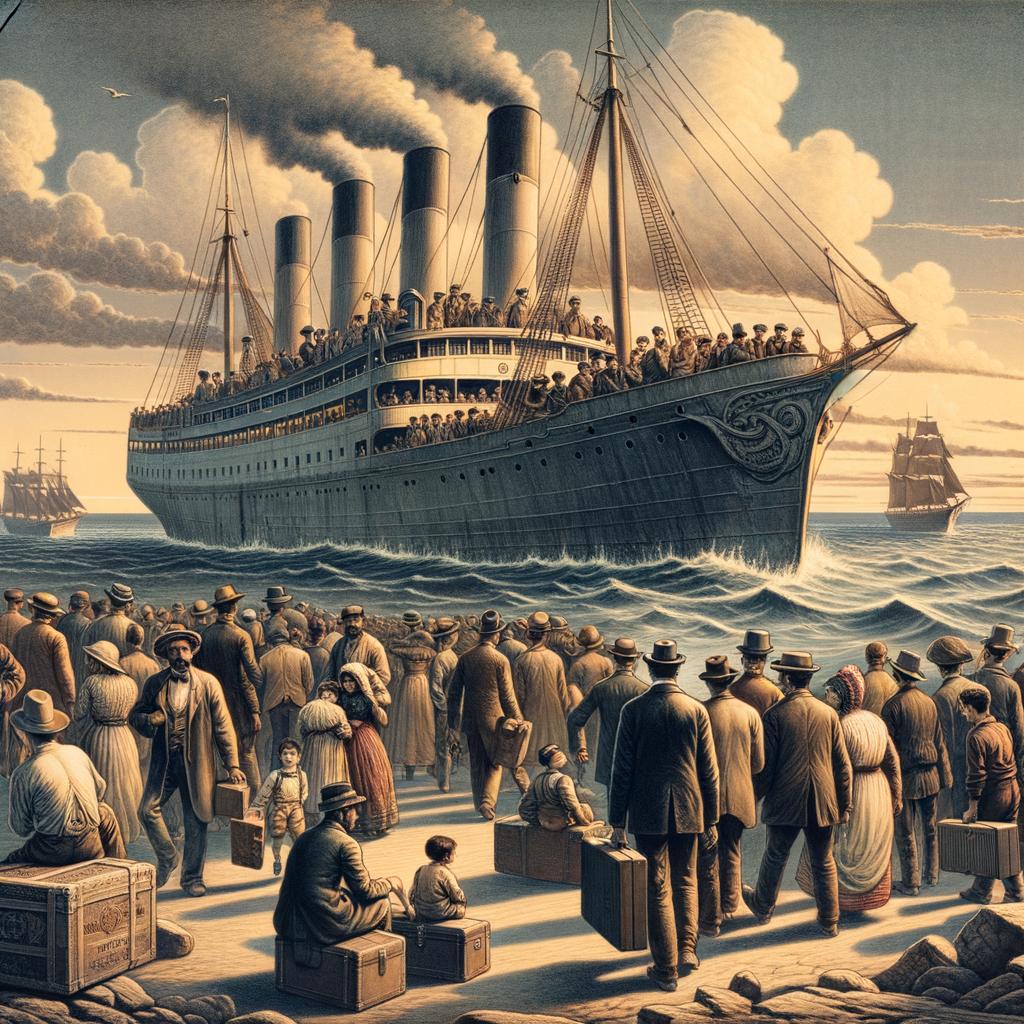How did immigrants travel to America from Italy? The Italian Immigration Wave in the late 19th and early 20th centuries saw millions of Italians leaving their homeland in search of better opportunities in America.
This article will explore the journey of Italian immigrants, from the push factors for their migration, to their departure from Italy, the transatlantic voyage, arrival at Ellis Island, and the challenges they faced in assimilating into a new culture. We will also delve into the enduring legacy and contributions of Italian immigration to American society.
During this time period, Italy experienced economic hardship, overpopulation, political instability, and lack of agricultural opportunity. These push factors prompted millions of Italians to seek a better life abroad. As a result, between 1880 and 1920, over four million Italians arrived in America – making it one of the largest waves of immigration in U.S. history.
The journey from Italy to America was arduous and challenging. Many immigrants traveled by steamship across the Atlantic Ocean – a voyage that lasted weeks and subjected them to cramped conditions, poor sanitation, and limited access to food and water.
Upon arrival at Ellis Island, they were faced with rigorous medical examinations and legal inspections before being admitted into the United States. Stay tuned as we uncover how Italian immigrants overcame these obstacles and built a lasting legacy in their new home.
Historical Context
The push factors for Italian immigration were deeply rooted in the historical context of Italy during the late 19th and early 20th centuries. At that time, Italy was characterized by economic hardship, overpopulation, and political instability, which led many Italians to seek better opportunities abroad. The Southern regions of Italy were particularly affected, as they faced extreme poverty and limited access to land and resources.
In search of a brighter future, many Italians made the difficult decision to leave their homeland behind and embark on a journey to America. The promise of employment, land ownership, and freedom from political turmoil drove thousands of Italian immigrants to set their sights on the United States. However, the question remained: how did immigrants travel to America from Italy?
The answer lies in the transatlantic voyage that would take them across the ocean to their new destination. Many Italian immigrants traveled by steamship, enduring crowded and uncomfortable conditions for weeks on end. These voyages were often perilous, with reports of disease outbreaks and overcrowding leading to harrowing experiences for those seeking a new life in America. Despite these challenges, the desire for a fresh start in a new country kept their spirits high throughout the difficult journey.
| Italian Immigration Push Factors | Transatlantic Voyage Conditions |
|---|---|
| Economic hardship | Crowded and uncomfortable conditions |
| Political instability | Disease outbreaks and overcrowding |
| Overpopulation | Weeks-long voyages |
The Journey Begins
Italy has a long history of emigration, with millions of Italians leaving their homeland in search of better opportunities abroad. The period between 1880 and 1920 saw a massive wave of Italian immigration to the United States, as economic hardship and overpopulation drove many to seek a new life across the Atlantic. The journey from Italy to America was not an easy one, and it often began with the difficult decision to leave behind family, friends, and familiar surroundings.
Travel Routes and Methods
Many Italian immigrants departed from ports such as Genoa, Naples, and Palermo, which were major hubs for transatlantic travel. Steamships were the primary mode of transportation for these immigrants, as they offered a relatively affordable and efficient means of traveling great distances. The journey across the Atlantic could take anywhere from 10 days to several weeks, depending on the weather conditions and the specific route taken by the ship.
Challenges Faced
The voyage itself presented numerous challenges for Italian immigrants. Crowded steerage class accommodations meant that many travelers had to endure cramped living conditions for the duration of their journey. Seasickness, poor hygiene, and limited access to fresh air made the experience even more grueling. Additionally, language barriers often made communication with crew members difficult, leading to feelings of isolation and vulnerability among the passengers.
Emotional Toll
The decision to leave one’s homeland and embark on a journey to an unknown country took a significant emotional toll on Italian immigrants. Many were leaving behind everything they knew in pursuit of a better future – a process that involved saying goodbye to loved ones with no guarantee of ever seeing them again.
This emotional burden added another layer of difficulty to an already arduous journey. As challenging as their passage may have been, it was only the beginning of their trials as they sought to establish themselves in America.
The Transatlantic Voyage
The journey from Italy to America for immigrants in the late 19th and early 20th centuries was a difficult and arduous one. The decision to leave their homeland was often driven by economic hardship, political instability, and limited opportunities. The promise of a better life in America fueled the wave of Italian immigration during this time period.
So, how did immigrants travel to America from Italy? The majority of Italian immigrants made the transatlantic voyage by steamship, with the journey typically lasting anywhere from 7 to 14 days. These ships were crowded and uncomfortable, especially for those traveling in steerage, which was the lowest class of accommodations. Many immigrants faced challenging conditions on board, including poor sanitation, limited food and water, and seasickness.
In addition to the difficult living conditions on board, Italian immigrants also faced significant emotional challenges during the transatlantic voyage. Many were leaving behind their families, friends, and everything they knew in search of a better future in America. The uncertainty of what awaited them on the other side often added to the stress and anxiety of the journey.
| Transatlantic Voyage | Immigrant Experience |
|---|---|
| Length: 7 to 14 days | Challenges: poor sanitation, limited food and water, seasickness |
| Emotional impact: Leaving behind families and everything they knew | Anxiety about the future in America |
Ellis Island
The gateway to America for Italian immigrants during the late 19th and early 20th centuries was Ellis Island. This iconic immigration station processed over 12 million immigrants, many of whom were from Italy, between 1892 and 1954. Upon arrival at Ellis Island, Italian immigrants underwent a series of inspections and interviews to gain entry into the United States.
Arrival and Inspection
Upon reaching Ellis Island, Italian immigrants were met with the sight of the main building, which served as the processing center for all arriving immigrants. Here, they underwent medical examinations to detect any signs of illness or disease, as well as legal inspections to ensure they met the requirements for entry into the United States.
Interviews and Registry
Italian immigrants also had to undergo a series of interviews to verify their identity, assess their ability to work and their potential impact on American society. Additionally, they were registered and given a number that would serve as their identification throughout their time in Ellis Island.
The Journey Inland
After passing through Ellis Island’s inspections and interviews, Italian immigrants were free to start their new lives in America. Many boarded trains headed further inland where they reunited with family members or sought out opportunities for work and settlement. This marked the end of their long journey from Italy and the beginning of a new chapter in their lives in America.
Overall, Ellis Island played a crucial role in shaping the experiences of Italian immigrants traveling to America. It both symbolized hope for a better life while also presenting considerable challenges as they navigated an unfamiliar country and culture. The enduring legacy of Italian immigration can still be seen today through its contributions to American society in areas such as food, art, music, language, and more.
The Challenges of Assimilation
Upon arriving in America, Italian immigrants faced a myriad of challenges as they sought to build a new life in a foreign land. From language barriers to cultural differences, the process of assimilating into American society was often fraught with obstacles. Here are some of the key challenges that Italian immigrants encountered as they began their new lives in America:
1. Language Barriers: For many Italian immigrants, one of the biggest hurdles to assimilation was overcoming the language barrier. Most immigrants spoke little to no English upon arrival, making it difficult for them to communicate with their new neighbors and navigate everyday life in America.
2. Discrimination and Prejudice: Italian immigrants also faced widespread prejudice and discrimination from native-born Americans. They were often viewed as inferior and faced unfair treatment in employment, housing, and social settings. This discrimination made it even harder for Italians to integrate into American society.
3. Economic Hardship: Many Italian immigrants arrived in America with little money or resources, forcing them to take on low-paying jobs with long hours and poor working conditions. Economic hardship made it difficult for Italians to achieve financial stability and upward mobility.
Despite these challenges, Italian immigrants persevered and made significant contributions to American society, particularly in the areas of food, music, art, and commerce. Their resilience and determination laid the foundation for a rich Italian-American heritage that endures to this day.
Overall, the challenges of assimilation were significant for Italian immigrants as they navigated their new lives in America. However, despite facing discrimination, economic hardship, and language barriers, they ultimately carved out a place for themselves in American society through hard work and perseverance. Their enduring legacy continues to shape the cultural tapestry of the United States today.
The Legacy of Italian Immigration
Italian immigrants made significant contributions to American society, leaving a lasting legacy that is still evident today. From the late 19th century to the early 20th century, millions of Italians sought better opportunities by immigrating to the United States. As they settled in various cities across the country, Italian Americans played a crucial role in shaping American culture, politics, and industry.
Here are some of the key contributions Italian immigrants made to American society:
- Cuisine: Italian cuisine has had a profound influence on American food culture. From pizza and pasta to gelato and espresso, Italian culinary traditions have become deeply ingrained in the fabric of American dining.
- Labor force: Italian immigrants made significant contributions to America’s labor force, particularly in industries such as construction, mining, and agriculture. Their hard work and skilled labor helped build many of the infrastructures that shape America’s cities and landscapes.
- Arts and entertainment: Italian Americans have also left their mark on the arts and entertainment industry. From iconic actors like Al Pacino and Sofia Loren to influential figures in music and literature, Italian Americans have made indelible contributions to American culture.
This enduring impact demonstrates how Italian immigrants have enriched American society in diverse ways. Their legacy continues to be celebrated and honored across the United States.
Conclusion
In conclusion, the enduring impact of Italian immigration to America cannot be overstated. The journey from Italy to America was a difficult and arduous one, with immigrants facing countless challenges and obstacles along the way. From the push factors driving Italians to leave their homeland to the hardships of the transatlantic voyage and the challenges of assimilation in the new world, Italian immigrants displayed remarkable resilience and determination in pursuit of a better life.
It is truly remarkable how did immigrants travel to America from Italy considering the limited resources and opportunities available to them at the time. Despite these adversities, Italian immigrants made significant contributions to American society, leaving a lasting legacy that can still be seen today.
Their impact is evident in various aspects of American culture, from food and fashion to art and music. The influence of Italian immigrants has helped shape the cultural fabric of America, making it richer and more diverse.
As we look back on the history of Italian immigration, we must recognize and celebrate the perseverance and tenacity of those who made the journey to America. Their courage and fortitude continue to inspire future generations, serving as a testament to the power of hope and determination in overcoming adversity. The enduring impact of Italian immigration serves as a reminder of the profound influence that immigrants have had on shaping American history and culture.
Frequently Asked Questions
How Did Immigrants Travel to America?
Immigrants traveled to America through various means, including steamships, sailing ships, and later on, airplanes. Many immigrants from Europe traveled in crowded and difficult conditions, facing long voyages across the Atlantic Ocean.
What Port Did Italian Immigrants Leave From?
Italian immigrants mainly left from the port of Naples in Italy. Naples was a major port city that served as a departure point for many Italian immigrants who were seeking a new life in America.
What Ship Did Italian Immigrants Take to America?
Italian immigrants primarily took ships such as the SS Conte di Savoia, SS Rex, or SS Vulcania to travel to America. These were large ocean liners that could accommodate a significant number of passengers and played a crucial role in transporting Italian immigrants to their new home.

I’m a passionate traveler, writer, and Italophile. My fascination with Italy’s history, art, and culture has led me on countless adventures across the Italian landscape. Through “I Live Italy,” I share my love for this extraordinary country and aims to inspire others to explore its boundless beauty.





